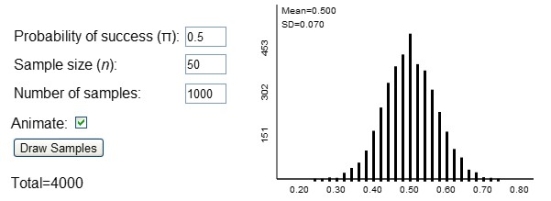Multiple Choice
The spinning dancer (or silhouette illusion) is a moving image of a woman that appears to be spinning. Some people see her spinning clockwise and some see her spinning counterclockwise. A student showed other students this and found that 30 out of 50 (or 60%) saw her spinning clockwise. The student researcher was interested in the probability of a randomly chosen student that would see the dancer spinning clockwise. He created the following null distribution for this. 
 Using the information provided above, determine a 2SD confidence interval for the long-run probability a randomly chosen student would see the woman spinning clockwise. (Don't use any other applet to do this, just the applet output and information above.)
Using the information provided above, determine a 2SD confidence interval for the long-run probability a randomly chosen student would see the woman spinning clockwise. (Don't use any other applet to do this, just the applet output and information above.)
A) (0.36, 0.64)
B) (0.46, 0.74)
C) (0.53, 0.67)
D) (0.43, 0.57)
Correct Answer:

Verified
Correct Answer:
Verified
Q44: A 2012 survey of 1,254 American cell
Q45: A 95% confidence interval for a population
Q46: Suppose a 95% confidence interval for a
Q47: Hill and Barton (Nature, 2005) conducted a
Q48: To investigate whether students tend to think
Q50: Researchers are studying a new weight-loss program.
Q51: Many studies have investigated the question of
Q52: A 95% confidence interval for a population
Q53: As the confidence level decreases, the width
Q54: Suppose you plan to offer a study